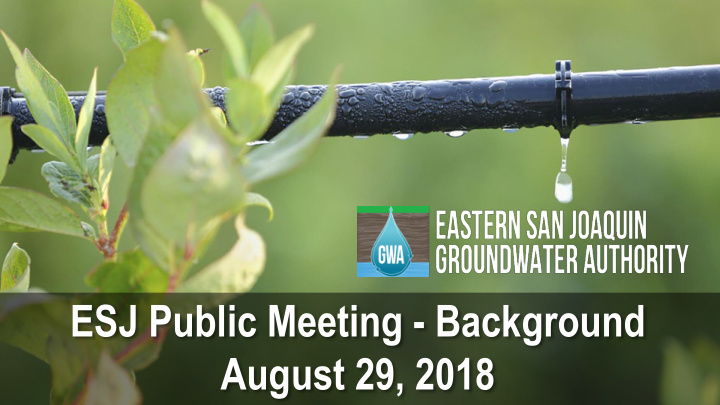



ESJ Public Meeting - Background August 29, 2018
About SGMA
What is SGMA? The Sustainable Groundwater Management Act , or SGMA, is new statewide legislation that establishes a path for the sustainable management of groundwater for the first time in California’s history. 3
What Does SGMA Require? • Groundwater Sustainability Agencies (GSAs) must be formed, and prepare and submit Groundwater Sustainability Plans (GSPs) by • January 2020 for critically overdrafted basins • January 2022 for remaining high and medium priority basins • GSPs must include measurable objectives and milestones in increments of five years to achieve sustainability within 20 years of GSP adoption • GSP development must be open and transparent 4
Eastern San Joaquin is Classified as Critically Overdrafted This means an accelerated GSP submittal deadline Eastern San of January 31, Joaquin Subbasin 2020 5
Eastern San Joaquin is Classified as a “High Priority” Basin If not critically overdrafted, all other high and Eastern San Joaquin medium priority Subbasin basins have a January 2022 deadline 6
GSP Development Approaches 1 Basin, 1 GSA, 1 Plan • One GSA assumes responsibilities and authorities for the entire basin • New or existing agency 1 Basin, Multiple GSAs, 1 Plan ESJ • Several GSAs in same basin Subbasin • Requires significant coordination among GSAs • Still evaluated based on basin-level implementation of GSP 1 Basin, Multiple GSAs, Multiple Plans • Flexibility in terms of responsibilities and authorities • Requires a single coordination agreement among all GSAs for the entire basin • Still evaluated based on basin-level implementation of GSP (could get messy) 7
GSPs are Required to Include Common Elements • Basin Setting • Undesirable Results & Sustainability Goals • Measurable Objectives, Minimum Thresholds, and Interim Milestones • Monitoring Network • Projects and Management Actions • Annual Groundwater Sustainability Plan (GSP) Reporting 8
SGMA Requires Accounting of All Water Uses and Sources Water Budget: • Accounting of the total groundwater and surface water entering and leaving a basin • Developed using the ESJ Basin’s calibrated and validated integrated groundwater-surface model 9
SGMA Requires Six Sustainability Indicators to be Addressed Chronic lowering of Significant and Significant and groundwater levels unreasonable unreasonable indicating a degraded water reduction of significant and quality groundwater storage unreasonable depletion of supply Depletions of Significant and interconnected surface Significant and unreasonable water that have unreasonable land seawater intrusion significant and subsidence unreasonable adverse impacts on beneficial uses of the surface water 10
SGMA in ESJ
Where is the Eastern San Joaquin Subbasin Boundary? 12
ESJ Subbasin: 17 GSAs, One GSP Eastern San Joaquin Groundwater Authority (GWA) includes all 17 GSAs plus California Water Service Company (Cal Water) Working collaboratively to develop a single GSP 13
Neighboring Basins Neighboring groundwater subbasins • Cosumnes • South American • Solano • Tracy • Delta-Mendota • Modesto 14
The ESJ GSP Prioritizes Local Control and Local Needs The purpose of the Eastern San Joaquin GSP is to develop a cost-effective plan for groundwater management that reflects the local needs and conditions and prioritizes and preserves local control over water resources while meeting the SGMA regulatory requirements for the California Department of Water Resources (DWR) by the January 31, 2020 deadline. 15
Basin Background
Topography and Basin Boundaries ESJ Subbasin boundaries: • North – Cosumnes River • West – San Joaquin River • South – Stanislaus River • East – Bedrock Outcrop 17
Several Rivers and Streams Traverse the Subbasin 18
ESJ is a Well-Monitored Subbasin – However, Some Data Gaps Exist 19
Agriculture is the Dominant Land Use in the Subbasin 20
Primary Cropping Patterns Have Changed Over Time 21
Private Domestic Wells Are Distributed Throughout the Basin 22
Average Domestic Well Depth Increases from East to West Average Domestic Well Depth (East-West Cross Section) 1000 Average Depth of Domestic 800 600 Wells (ft) 400 200 0 0 5 10 15 20 25 30 35 Miles Eastward from Western Basin Border Source: Online System for Well Completion Reports 23
Current Basin Conditions
Current Groundwater Elevations Some Areas Have Recovered and Some Have Declined Since 1992 Drought (blue) – Areas that have recovered since 1992 (red) – Areas that have declined since 1992 25
The Basin has Large Amounts of Groundwater in Storage – the Problem is Reaching It This graph shows freshwater only 26
Groundwater Quality Salinity Contamination of Freshwater Wells is a Concern in Some Areas 27
Subsidence is Not a Concern in the Subbasin • The area with subsidence Data Source: USGS, by Page (1986), Central Valley Hydrogeologic Model Contours of Corcoran Clay Thickness potential (where there is pumping from below the Corcoran Clay layer) is limited • Groundwater elevations in this area are typically high compared to the rest of the basin, and subsidence is not likely 28
ESJ Public Meeting - Background August 29, 2018
Recommend
More recommend